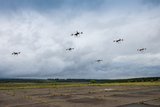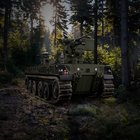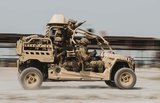Lockheed Martin tactical reconnaissance radar begins test flights aboard Predator B 'MQ-9' UAS
A milestone has been achieved, the first flight of Lockheed Martin's Tactical Reconnaissance and Counter-Concealment-Enabled Radar (TRACER) aboard an MQ-9 Unmanned Aerial System. The milestone also marks the first time a penetrating radar has flown on a fixed wing unmanned aerial system. TRACER, a dual-band synthetic-aperture radar (SAR), detects vehicles, buildings and other man-made objects that are buried, camouflaged or concealed under foliage in real-time. TRACER will continue flight testing and system validation in multiple environments.
TRACER's design is predicated on Lockheed Martin's proven foliage penetration (FOPEN) technology, which incorporates dual-band synthetic aperture radar, and provides high resolution images to ground units in all-weather, day or night conditions, as well as operating in various collection modes. TRACER has already successfully completed approximately one hundred test flights on manned platforms.
"This demonstrates the maturity of penetrating SAR and that TRACER is clearly deployment ready," said Jim Quinn, vice president with Lockheed Martin's Information Systems & Global Solutions-Defense. "When deployed, this "hunting" sensor can use the penetrating RADAR capability to provide ground commanders with intelligence not available from a traditional optical sensor."
The purpose of these test flights is to demonstrate the ability to operate the radar remotely utilizing a high endurance platform. The TRACER configuration aboard the MQ-9 also utilizes an external unpressurized pod to house the RF portion of the system. The tests aboard a NASA-operated Predator B (Ikhana) unmanned aircraft is underway. During the flight testing, the system will collect high resolution SAR imagery. The Ikhana performed as a surrogate for the Army's "Gray Eagle" (MQ-1) unmanned aerial system, which was not available because of current mission critical needs. The flight tests on the Ikhana focused on the radar's performance in the harsh environment of the unpressurized pod, and are intended to mitigate risk for eventual installation on the Army UAS.
TRACER is unique in that it will provide the Army with tactical penetrating radar that is deployable on both manned and unmanned platforms in a variety of environments. The dual band capability of TRACER increases target detection over a variety of terrain and concealment scenarios. TRACER also incorporates data link technology that allows airborne processed results to be down-linked to ground stations immediately. The system includes a portable ground station to plan, collect, support missions, and exploit imagery.
Source: Lockheed Martin
More from Uncrewed Vehicles
-
![Ready for the race: Air separation drone swarms vs. air defence systems]()
Ready for the race: Air separation drone swarms vs. air defence systems
As the dynamics of aerial combat rapidly evolve, Chinese scientists have engineered a sophisticated air separation drone model that can fragment into up to six drones, each capable of executing distinct battlefield roles and challenging the efficacy of current anti-drone defences such as the UK’s Dragonfire laser system.
-
![Israel’s MALE UAVs ‘must adapt’ to Iranian-made air defences]()
Israel’s MALE UAVs ‘must adapt’ to Iranian-made air defences
Advancements in air defence technologies have begun to reshape aerial combat dynamics in the Middle East, as illustrated by recent events involving the Israeli Air Force and Hezbollah.
-
![Hundreds more UAS sent to Ukraine forces with thousands more on the way]()
Hundreds more UAS sent to Ukraine forces with thousands more on the way
Both sides of the Russia-Ukraine war have been using UAS for effective low-cost attacks, as well as impactful web and social media footage. Thousands more have now been committed to Ukrainian forces.
-
![AI and software companies selected for US Army Robotic Combat Vehicle subsystems]()
AI and software companies selected for US Army Robotic Combat Vehicle subsystems
The US Army has intentions to develop light, medium and heavy variants of the Robotic Combat Vehicle (RCV) as part of the branche’s Next Generation Combat Vehicle family.
-
![DroneShield to improve software of DroneSentry-X C-UAS system under new contract]()
DroneShield to improve software of DroneSentry-X C-UAS system under new contract
DroneSentry-X, a cross-vehicle compatible, automated 360° C-UAS detect and defeat device, can offer 360° awareness and protection using integrated sensors. According to its manufacturer, it is suitable for mobile operations, on-site surveillance and on-the-move missions.
-
![Ukraine takes delivery of new indigenous C-UAS systems]()
Ukraine takes delivery of new indigenous C-UAS systems
Funded by the country’s former president, the new C-UAS systems will be sent to the frontline where they have already been tested against Russian invading forces.


























